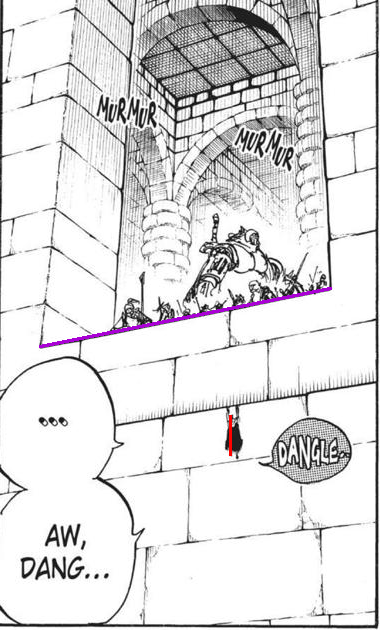- 31,838
- 28,504
I was going to address all the calculations at once but since Method 4 is being highlighted as the one that people are agreeing with, I'll get this one out the way first while I'm still gathering together all the necessary scans for the other methods:
Method 4
This method calcs the speed at which the Birdcage is moving at (9.87552 m/s) and assumes that if the Birdcage was moving at this speed for the whole hour duration that Doflamingo declared in chapter 781 then the longer distance of its uneven travel would be 35.551872 km, which would make the entire diameter of Dressrosa to be 50.0136504407 km.
The biggest problem that I can see with this method is that the scene that is used to calculate the speed of the Birdcage comes from an adaptation of the end of chapter 788, here.
But at the end of chapter 787 and the beginning of chapter 788, it is noted that Doflamingo purposefully increased the speed at which the Birdcage is moving in order to pressure Luffy.
So the Birdcage wouldn't have been travelling this quickly for the entire 1 hour duration from the start so we can't use that timeframe for it, meaning this method can't be used in its current state.
In fact, I believe if we combine two pieces of evidence here (which is A) that the sped-up version of Birdcage is 9.87552 m/s, and B) it would take 3 minutes of the sped-up version of Birdcage to reach the central zone of Dressross and start causing mass deaths) then we would end up with a size value of Dressrosa that is far smaller than 50 kilometers.
For example, this was just put together quickly by me but since the colosseum is noted to be just on the border of the central zone of Dressrosa in this diagram, then using this pixelscaling and the speed provided by Method 4 for the Birdcage and a timeframe of 3 minutes provided to us by the manga, we'd get a size of just over 12.6 km for Dressrosa's diameter.
Method 4
This method calcs the speed at which the Birdcage is moving at (9.87552 m/s) and assumes that if the Birdcage was moving at this speed for the whole hour duration that Doflamingo declared in chapter 781 then the longer distance of its uneven travel would be 35.551872 km, which would make the entire diameter of Dressrosa to be 50.0136504407 km.
The biggest problem that I can see with this method is that the scene that is used to calculate the speed of the Birdcage comes from an adaptation of the end of chapter 788, here.
But at the end of chapter 787 and the beginning of chapter 788, it is noted that Doflamingo purposefully increased the speed at which the Birdcage is moving in order to pressure Luffy.
So the Birdcage wouldn't have been travelling this quickly for the entire 1 hour duration from the start so we can't use that timeframe for it, meaning this method can't be used in its current state.
In fact, I believe if we combine two pieces of evidence here (which is A) that the sped-up version of Birdcage is 9.87552 m/s, and B) it would take 3 minutes of the sped-up version of Birdcage to reach the central zone of Dressross and start causing mass deaths) then we would end up with a size value of Dressrosa that is far smaller than 50 kilometers.
For example, this was just put together quickly by me but since the colosseum is noted to be just on the border of the central zone of Dressrosa in this diagram, then using this pixelscaling and the speed provided by Method 4 for the Birdcage and a timeframe of 3 minutes provided to us by the manga, we'd get a size of just over 12.6 km for Dressrosa's diameter.
Last edited:


